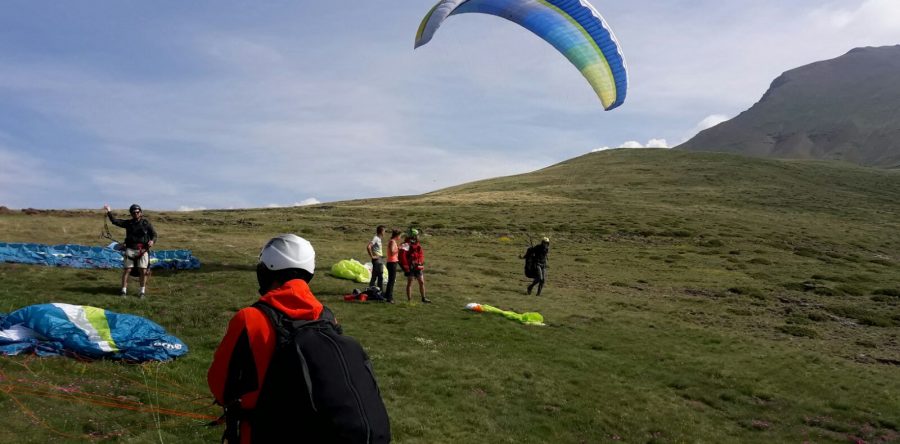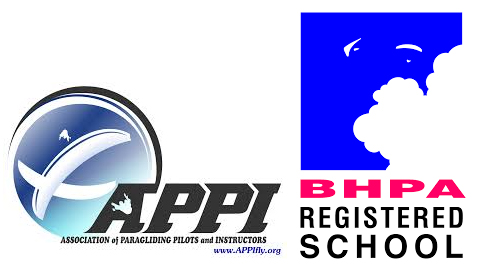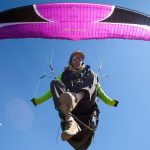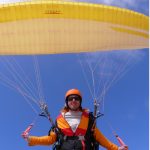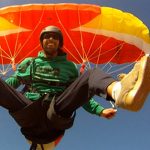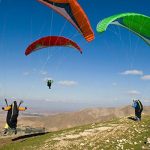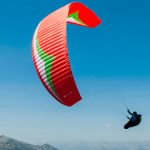Here you have some tips and advice for new paragliding pilots by Russell Ogden, who works for Ozone Paragliders as a test pilot.
Looking for a Paragliding Centre
There are loads of places that you can get information about Paragliding Centres. These days the Internet is probably the best place. If you do a search on the internet for paragliding you'll get lists of pages and lots of schools in your local area or the whole country. You can also contact the National Federation in each country and they will be able to give you a list of all the paragliding training centres that are available.
Choosing a good paragliding school
Choosing a paragliding school depends on your area. The best thing to do if you know someone who flies is to ask their opinion but otherwise just go for your local school, because sometimes the learning process can take some time, so you don't want to be in a school that's maybe 300 kilometres away. So going to a local school.
I think is important that you can give the sport time and give it your weekends which is
basically what you need to be able to fly properly. Once you learn flying, I'd say the important thing is to its continuity rather than doing some days and then having a few months off and going back to it you never get past that first stage. If you can do several days in a row, or preferably a week course, then you'll get a much better understanding and you'll progress much faster because you're not always taking those backwards steps that long brakes entail. So doing a week course is a very good idea or if you can't take the time off work then devoting your weekends.
Learn to paraglide
Learning to paraglide is really important and that carries on throughout your whole flying careers. It's really important that you remain continuous in your learning process and you don't get too rusty. I think the most important thing whilst you're learning and throughout your whole flying career is ground handling; It is being able to control your glider on the ground. The takeoff is probably the area where there are most accidents and it's the most dangerous part of the flight. So being perfect that your takeoffs are the aim and that should never stop throughout your whole flying career, something that you always practice, especially if you have a period where you haven't flown for a while, then just put in half an hour on the ground is really useful for you. This not only does that keep you safe on the takeoff but when you're flying in the air and you start flying in more demanding conditions and there are stronger thermals and so on then the skills are keeping the bladder inflated on the ground directly transpose what's the word directly related to the way that you control your glider in the air. So if you have very good skills on the ground and you can keep your glider inflated in a gusty wind or a light wind, then you'll be able to do so in the air more easily you'll also be more relaxed, which is really important for flying.
If you start to get scared and you start to tense up then all your actions and your movements and not so good if you can be relaxed and you'll be able to think a little bit more clearly and keep the glider flying safer.
When learning to paraglide or when flying, fear is a major part of our sport. We're not designed to fly tall with terrestrial beings, so overcoming those fears is a very important part of flying. But also having those fears are very important because without fear you can start maybe doing reckless things, as flying in conditions that you shouldn't be flying or on wings that you shouldn't be flying.
Fear happens to all pilots. Every pilot goes through it no matter what level they're at and being able to control those fears are really important. Often, fear or that inner voice that you have, is telling you something important and you should always listen to your inner
voice. Often, fear comes down to the fact that maybe you feel that your skills are not up to it which means that well maybe you should take a step backwards and practice your ground handling more or practice simple flying in smooth conditions more before you start progressing on to flying in thermic conditions, or of big mountains. You can also enrol in an intermediate level paragliding course run by professional instructors.
So, I think fear is a very important part of flying and it's what keeps us alive. At the moment that you lose fear is the time that you should be careful because that's when you might start to try and overextend yourself maybe stepping up a glider level that's too much for you or flying in conditions that are too strong.
Buying your first paraglider
Buying a glider is exciting but there's so much choice out there that it's very hard as a new pilot to make an informed decision. The thing I would recommend is to listen to your instructor and take your instructor's advice.
Some people will try and sell you gliders to the cheat that may be old and I don't recommend doing that. When gliders get old they become less safe, the flying characteristics change. So if you can afford it I would go I'd always buy a new glider and I'd
go for a level of glider that your instructor feels is right for you.
Nowadays the best bet is as a first wing is to fly a DHV 1 glider: they're designed specifically for new pilots. They're easier to take off, they're easier to ground handle, they're less likely to deflate and if they do deflate, then far better behaved than some
of the other wings and high-performance wings. So the DHV 1 gliders are more forgiving and yet they're still great fun to fly- They're still brilliant at noon thermals they can climb really well. they lose a little bit of performance on glide but it's only a very small amount and it's only really noticeable if you're using your speed bar a lot which generally as as your first wing you don't use so much. SO, I'd go for a DHD one glider and I'd go for a newer one as I can get and put your time and learn the score in the safest possible way.
Trust your instructor
Paragliding is a dangerous sport, you need to reduce danger and you do that by getting the
best equipment you can. Harnesses these days you can get large Cygnus type airbags which inflate underneath you. They're a great idea for a new pilot, so when you're learning the best thing to do is to trust your instructor; is to listen to your instructor invariably, there'll be very experienced, they may have been flying for a long time and they've taught many people. So they know how people learn and they can change the way they teach to different standards of students. So trust your instructor, listen to your instructor and follow the advice of your instructor.
Afterwards, it comes down to practice and it comes down to dedication and you need to put the time in on the ground forward launching, reverse launching, all the different methods of launching.
Around Europe you'll see different types of pilots: in England, for example, people generally a relatively good at reverse launching because we fly in wind. A lot but they hate to do forward launches. In France sometimes it's the other way around, you don't see pilots doing many reverse launches.
So if you do have a weakness if you feel that oh my I don't use forward launch because I'm not very good at it they're not telling you that's something you need to work on the aim is to try and perfect and to run become as rounded a pilot as you can. So throughout your flying career, you want to look at areas that you're not comfortable with and maybe consider learning about those areas also going on advanced courses is important once
you're qualified that's not it there's still the whole game to learn at the aim of the school is to make you into a person who knows who's safe and knows the dangers of the sport.
Once you leave that school environment that's when it can become dangerous. sS taking advice from other pilots on the hill is really important; if there are more experienced pilots are not flying there's generally a reason for it. So it's always good to ask people to introduce yourself as a new pilot and get as much information as you can. Absorb as much information as you can; watch every DVD there is or to read every book, try and get all the
information you can.
Paragliding Advanced courses and Guidance to keep progressing
There are also advanced courses where you can learn how to thermal correctly under guidance.
Flying cross-country in from country to country is different. If you generally live an area of flat land then when you come to the mountains it's a different game altogether, so it's a good idea to take professional advice from a local paragliding guide so that you don't put yourself into a dangerous position without even knowing it as your skills develop and you fly potentially in more strong conditions and on more high-performance wings, that might be the time that you
want to consider doing an SIV course where you learn how to control your glider in abnormal conditions, i.e. if it's had deflation and so on it's best to do that in a safe controlled environment, but over water with a lifejacket and an instructor rather than to discover what a deflation is like when you're ten meters above a cliff face. So advanced paragliding courses are not the be-all and end-all of becoming a good pilot but they certainly help you make become a safer pilot and make you feel and understand the wing a lot better.
This post is a transcription of the video "Learn to Fly" (Kitchen Productions)

